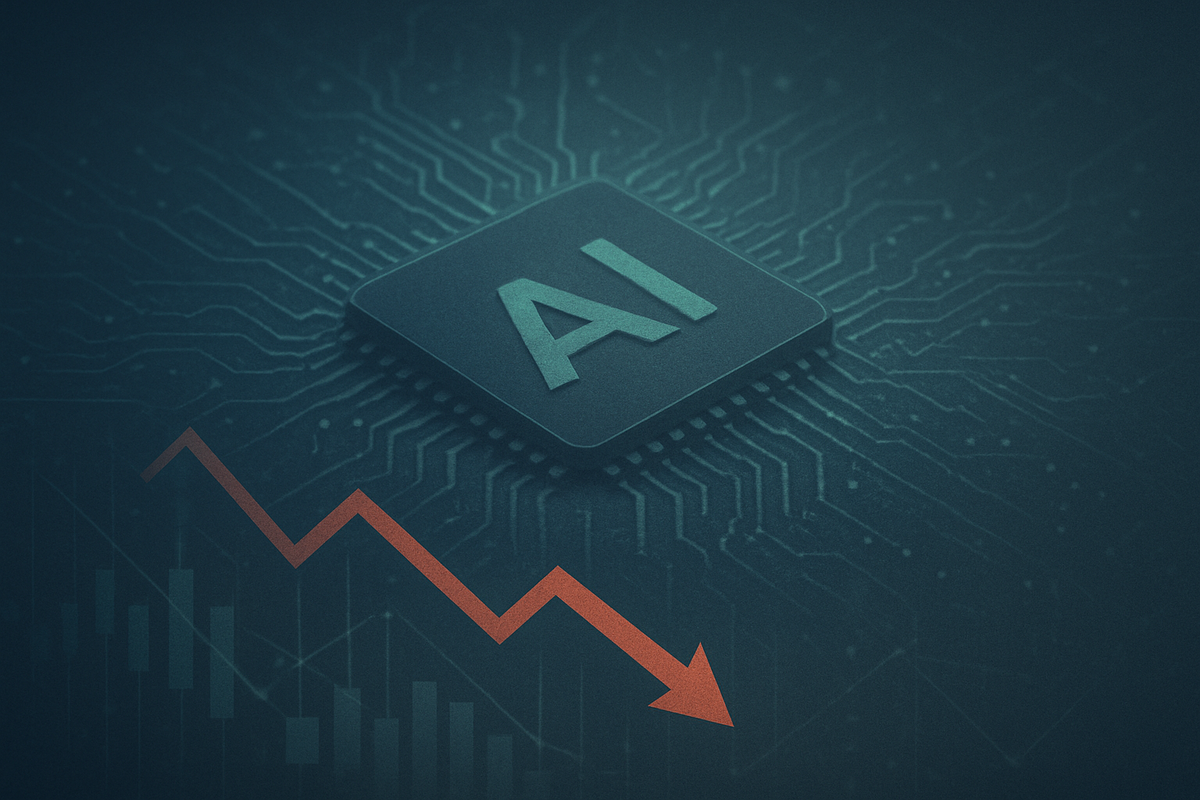
The once-unbridled enthusiasm for Artificial Intelligence (AI) has hit a significant snag in early November 2025, as investor sentiment cools and leading AI chip stocks, including industry titan Nvidia (NASDAQ: NVDA), experience a notable decline. This market recalibration, marked by sharp drops across tech-heavy indices, signals a shift from speculative exuberance to a more pragmatic demand for tangible returns and sustainable business models within the burgeoning AI landscape. The immediate implications include increased market volatility, a re-evaluation of high valuations, and a broader "risk-off" sentiment impacting the technology sector.
This downturn is prompting a crucial re-assessment across global financial markets, as investors and analysts alike question the sustainability of the "AI bubble" and the pace at which corporate earnings can justify the sky-high expectations for AI companies. While the long-term transformative potential of AI remains widely acknowledged, the current period underscores a critical juncture where the industry transitions from a phase of "dazzle to delivery."
Detailed Coverage: A Week of Reckoning for AI Chip Giants
The first week of November 2025 witnessed a pronounced downturn in the AI chip sector, with Nvidia (NASDAQ: NVDA) at the epicenter of the market's unease. On November 4, Nvidia's stock closed down 3.96% at $198.69, contributing to a staggering loss of approximately $450 billion in market capitalization over a three-day period – its most significant wipeout since January 2025. This slide was not isolated, as the tech-heavy Nasdaq Composite and the S&P 500 recorded their largest one-day percentage drops in nearly a month, with the Nasdaq falling 2% and the S&P 500 over 1% on November 4.
The events leading up to this moment reflect a culmination of factors. For months, Nvidia had enjoyed continuous progress, even briefly achieving a $5 trillion market valuation earlier in November, cementing its dominance in the AI accelerator market. However, concerns about "expensive equity valuations" had been resurfacing periodically throughout 2025. By early November, these anxieties reached a fever pitch, fueled by widespread profit-taking after extended gains, and warnings from prominent Wall Street executives about a potential serious market correction. The "Magnificent Seven" AI-related stocks—Nvidia (NASDAQ: NVDA), Amazon (NASDAQ: AMZN), Apple (NASDAQ: AAPL), Microsoft (NASDAQ: MSFT), Tesla (NASDAQ: TSLA), Alphabet (NASDAQ: GOOGL), and Meta (NASDAQ: META)—all experienced one-day falls. Palantir Technologies (NYSE: PLTR), a key AI data analytics player, notably slumped almost 8% despite raising its revenue outlook, highlighting the broad nature of the investor pullback.
Key players and stakeholders involved in this market shift include not only the aforementioned tech giants but also other significant chip manufacturers like Advanced Micro Devices (NASDAQ: AMD) and Intel (NASDAQ: INTC), both of whom saw their stocks affected. Taiwan Semiconductor Manufacturing Co (NYSE: TSM), a crucial third-party foundry for many AI chip designers, also experienced a dip. Furthermore, suppliers like Advantest (OTC: ATEYY), an Nvidia supplier, tumbled as much as 10.2%. Investors and analysts, including figures like Michael Burry—famous for predicting the 2008 financial crisis—who reportedly bet against Palantir and Nvidia, further fueled the market jitters. Geopolitical factors also played a role, with news in early November 2025 indicating that the U.S. government would not permit the sale of Nvidia’s latest scaled-down Blackwell AI chips to China, further weighing on the company's stock.
Initial market reactions were characterized by a debate: was this a healthy correction after an extended climb, or the harbinger of a more severe slide? While some pointed to Nvidia's robust $500 billion order portfolio as a sign of underlying strength, the market appeared to prioritize valuation concerns and profit-taking, underscoring a prevailing sentiment that the AI sector had become overheated.
Winners and Losers in the AI Reassessment
The cooling sentiment in the AI sector and the subsequent decline in chip stocks have created a distinct landscape of potential winners and losers, forcing a re-evaluation of company strategies and investor portfolios.
Among the losers, companies with extremely high valuations and unproven monetization strategies are particularly vulnerable. Nvidia (NASDAQ: NVDA), despite its market leadership, has seen significant stock volatility and is facing challenges with market access for its advanced chips in regions like China. Palantir Technologies (NYSE: PLTR), with its staggering valuation, has been a prime target for short-sellers and experienced notable plunges. Other "Magnificent Seven" AI-related stocks, while diversified, also felt the pressure. Smaller AI startups with generic platforms or lacking clear product-market fit face immense difficulty in securing funding at previous valuations, leading to potential consolidation or shutdowns. Indian AI proxy stocks, which had seen significant rallies, are now experiencing volatility and corrections. Oracle (NYSE: ORCL) is also cited by some analysts as potentially facing a shift in its competitive moat.
Conversely, a new set of winners is emerging, characterized by strong fundamentals, specialized offerings, or critical infrastructure roles. Broadcom (NASDAQ: AVGO) appears to be a direct beneficiary, providing custom AI accelerators that offer superior performance-per-watt at lower costs. Broadcom has reportedly secured a $10 billion deal for its Titan AI inference chip from a major AI player like OpenAI, positioning it favorably. Taiwan Semiconductor Manufacturing Co (NYSE: TSM) maintains a neutral and advantageous position as a foundry, manufacturing chips for various designers, and its upcoming advanced 2nm chips are expected to drive significant demand. Hyperscalers like Microsoft (NASDAQ: MSFT), Alphabet (NASDAQ: GOOGL), and Amazon (NASDAQ: AMZN), despite initial stock dips, are generally more resilient due to their extensive cloud computing services and robust AI ecosystems, allowing them to monetize the AI boom through enterprise solutions and software integration. They also possess the capital for substantial, internally financed AI infrastructure investments. Companies providing essential AI infrastructure and optimization tools, or specialized AI startups with proven product-market fit and a focus on domain-specific problems, are also poised to thrive in this more discerning market. United Rentals (NYSE: URI) is an example of a company with strong, consistent return on assets, benefiting indirectly from the AI boom through equipment manufacturing while maintaining a robust business model.
Indirectly, the energy and utilities sector stands to gain from the explosive energy demand of AI data centers, creating opportunities for energy providers, particularly in renewable energy and the uranium sector. Companies offering AI-powered solutions for procurement and supply chain optimization may also see continued demand. The venture capital landscape will also transform, prioritizing companies with demonstrable product-market fit and clear paths to profitability, potentially leading to a healthier long-term AI ecosystem.
Wider Significance: A Paradigm Shift and Echoes of the Past
The cooling sentiment in the AI sector and the decline of AI chip stocks in November 2025 signify a profound paradigm shift, moving the industry from an era of speculative optimism to one demanding tangible value and sustainable growth. This recalibration is not merely a market blip but a critical re-evaluation that fits into broader industry trends focused on profitability, efficiency, and responsible innovation.
The market correction is driven by several factors, including extreme valuations—some AI companies trading at P/E ratios as high as 700x—and a "productivity paradox" where widespread AI adoption has yet to translate into material enterprise-level benefits for many. The market concentration risk, with Nvidia (NASDAQ: NVDA) alone representing roughly 8% of the S&P 500, has also raised systemic concerns. This shift is creating significant ripple effects. While dominant players like Nvidia (NASDAQ: NVDA) and Advanced Micro Devices (NASDAQ: AMD) face stock declines, smaller AI startups are particularly vulnerable, facing increased difficulty in securing funding as investors prioritize demonstrated value. Even the "Magnificent Seven" tech giants have felt the pressure, indicating a broad re-evaluation across the sector. Cloud providers and infrastructure companies, however, continue to see demand for the "shovels and picks" required for the AI gold rush.
Regulatory and policy implications are also coming to the forefront. Financial institutions and regulators are raising alarms about systemic risks stemming from AI market concentration, increased market correlations, and cyber risks. Antitrust investigations into AI market concentration are anticipated, and the future of federal AI regulation in the U.S. remains uncertain, particularly with President-elect Donald Trump planning to rescind President Joe Biden's executive order on AI. This creates a complex compliance landscape, compounded by growing scrutiny over the massive energy consumption of AI data centers, with regulators beginning to consider limits on large new digital loads.
Historically, the current situation draws strong comparisons to the dot-com bubble of 2000. Both eras exhibited extreme valuations, widespread speculation, accelerating infrastructure investment, and a fundamental disconnect between investment levels and actual business value creation. Michael Burry's (Scion Asset Management) bets against AI giants like Nvidia (NASDAQ: NVDA) and Palantir (NYSE: PLTR) further underscore these parallels. However, a key difference is that many leading AI companies today, such as Nvidia (NASDAQ: NVDA), Microsoft (NASDAQ: MSFT), and Alphabet (NASDAQ: GOOGL), are established, profitable, and cash-rich, often financing AI investments internally rather than through risky leverage. This suggests that while a correction is underway, it may be a market reset leading to a more mature and integrated AI ecosystem rather than a complete collapse, echoing the "productivity paradox" where the internet's significant payoff lagged initial hype before transforming the global economy.
What Comes Next: Navigating the AI Maturation Phase
The cooling sentiment and recent decline in AI chip stocks mark a pivotal moment, ushering in a "maturation phase" for the AI sector. While short-term volatility is expected to persist, the long-term trajectory for AI remains fundamentally robust, albeit with a renewed emphasis on sustainable growth and profitability.
In the short-term (next 6-12 months), the market will likely be characterized by continued volatility and potential for further corrections. Investors will increasingly scrutinize company fundamentals, differentiating between genuine AI innovation and mere hype. The initial hyper-growth phase may moderate, shifting towards optimization and strategic upgrades of existing AI infrastructure. Upcoming quarterly earnings reports will be critical indicators of companies' ability to navigate this environment. Competition is also set to intensify, with players like Qualcomm (NASDAQ: QCOM) preparing to ship AI chip computing clusters in 2026, and Advanced Micro Devices (NASDAQ: AMD) launching new GPUs, while Chinese chipmakers aim to triple AI chip output to reduce reliance on foreign technology.
Long-term (1-5+ years), the fundamental drivers for AI remain strong. The demand for high-performance computing components, advanced logic chips, and High-Bandwidth Memory (HBM) is fueling a "silicon supercycle," with the AI chip market projected to grow from over $150 billion in 2025 to potentially $400 billion by 2027. A significant shift towards inference workloads, favoring specialized ASIC chips for their efficiency, is also anticipated by 2030. Technological advancements like 2nm process technology and co-packaged optics will continue to reshape performance. Nvidia (NASDAQ: NVDA) is expected to remain a dominant force due to its comprehensive ecosystem, but there will be a broadening of AI applications across various sectors beyond data centers, including consumer electronics, automotive, and healthcare.
Strategic pivots and adaptations will be crucial. Companies must focus on translating technological prowess into tangible, measurable returns and sustainable business models, moving beyond high capital burn. Verticalization and specialization in AI solutions for specific industries will gain traction. Supply chain diversification and resilience will become paramount given geopolitical risks. Addressing the massive energy consumption of AI data centers will also be a critical challenge, driving innovations in energy efficiency. Over half of downstream organizations doubt the semiconductor industry's ability to meet their needs, leading one in three to explore or actively engage in in-house chip design for greater customization.
Market opportunities lie in emerging AI applications like edge AI, specialized AI infrastructure, and ethical AI solutions. The continued build-out of data centers and demand for custom silicon will also present significant opportunities. However, challenges include persistent valuation concerns, intensifying competition, geopolitical tensions, supply chain vulnerabilities, and the vast energy demands of AI. A dearth of skilled professionals for AI implementation also poses a significant hurdle.
Potential scenarios range from a healthy correction and sustainable growth, where valuations reset and underlying demand drives more measured growth, to an optimistic rapid rebound, or a pessimistic prolonged downturn and "bubble burst", particularly for companies with stretched valuations and unclear paths to profitability.
Comprehensive Wrap-up: A Maturing Market Demands Substance
The cooling sentiment in the AI sector and the decline of AI chip stocks in November 2025 represent a significant inflection point, marking a transition from an era defined by speculative fervor to one demanding tangible value and sustainable growth. This market correction is a necessary reality check, compelling companies and investors alike to scrutinize fundamental economics and long-term viability.
Key takeaways include the widespread concern over inflated valuations, the "AI bubble" warnings from financial leaders, and Nvidia's (NASDAQ: NVDA) historic valuation followed by a substantial drop. The phenomenon of "Pilot Purgatory," where AI pilot programs struggle to scale to profitable implementation, highlights a growing realism about AI's limitations, including high computational costs and energy usage. Regulatory headwinds and "AI washing" fatigue are further contributing to investor skepticism, alongside a concentration of investment in a few dominant players like OpenAI and Nvidia.
Moving forward, the market is entering a maturation phase. While short-term volatility is anticipated, the long-term outlook for AI remains fundamentally strong, driven by continued infrastructure build-out and a shift towards monetization of earlier investments. The AI hardware market, particularly chips and accelerators, is poised for steady growth, with enterprises increasingly investing in in-house AI infrastructure. The industry is evolving from inflated expectations to a grounded reality, prioritizing ethics, trust, profitability, and long-term business value. AI is not disappearing; it is becoming "smarter, leaner, and more useful."
The lasting impact of this period will likely be a more resilient and integrated AI sector. Successful applications will be deeply embedded into various industries, driving efficiency and innovation based on proven results rather than speculative promises. The focus will firmly shift from "what AI can do" to "what AI profitably can do" in real-world scenarios.
Investors should watch for several key indicators in the coming months. Prioritize companies demonstrating genuine AI-driven value creation, measurable customer outcomes, and sustainable competitive advantages that justify significant development costs. Look for diversification beyond the hyperscalers, with opportunities emerging in specialized chips and AI solutions for enterprise needs, as well as edge computing. Closely monitor geopolitical and supply chain risks, particularly those impacting the semiconductor industry. Pay attention to how companies address the immense energy consumption of AI development and evolving regulatory frameworks. Most importantly, be wary of extreme valuations and scrutinize financial fundamentals. The era of "buy anything with AI in the name" is definitively fading, giving way to a more discerning investment landscape.
This content is intended for informational purposes only and is not financial advice





